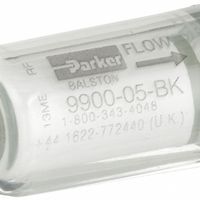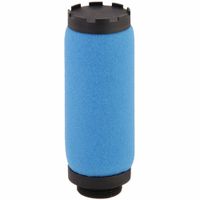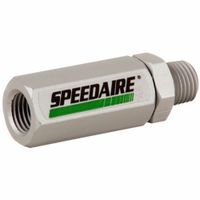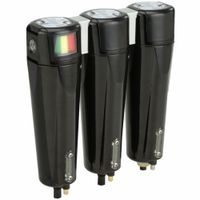Call +(254) 703 030 000 / 751 483 999 / 721 704 777
- Home
- Pneumatics
- Compressed Air Treatment
- Compressed Air Filters
.....Read More
Frequently Asked Questions
What are the benefits of installing air filters in compressed air systems?
Installing air filters in compressed air systems offers several benefits:
1. **Contaminant Removal**: Air filters effectively remove dust, dirt, oil, moisture, and other contaminants from the compressed air, ensuring cleaner air output. This is crucial for maintaining the quality of end products, especially in industries like food and pharmaceuticals.
2. **Equipment Protection**: By filtering out harmful particles, air filters protect downstream equipment such as valves, cylinders, and pneumatic tools from wear and tear, reducing maintenance costs and extending equipment lifespan.
3. **Improved Efficiency**: Clean air reduces the risk of blockages and pressure drops in the system, leading to more efficient operation. This can result in energy savings and lower operational costs.
4. **Product Quality**: In manufacturing processes, the presence of contaminants can compromise product quality. Air filters help maintain high standards by ensuring that only clean air comes into contact with products.
5. **Reduced Downtime**: By preventing equipment failure and reducing the need for frequent maintenance, air filters help minimize system downtime, ensuring continuous and reliable operation.
6. **Compliance with Standards**: Many industries have strict air quality standards. Installing air filters helps companies comply with these regulations, avoiding potential fines and ensuring safe working conditions.
7. **Corrosion Prevention**: Moisture and oil in compressed air can lead to corrosion in pipes and equipment. Air filters remove these elements, preventing corrosion and associated damage.
8. **Cost Savings**: While there is an initial investment in air filters, the long-term savings from reduced maintenance, energy efficiency, and extended equipment life can be significant.
9. **Environmental Benefits**: By improving system efficiency and reducing energy consumption, air filters contribute to a lower carbon footprint, supporting environmental sustainability initiatives.
How do you choose the right air filter for a compressed air system?
To choose the right air filter for a compressed air system, consider the following factors:
1. **Contaminant Type**: Identify the contaminants present, such as particulates, oil, moisture, or odors. Different filters target specific contaminants.
2. **Filtration Efficiency**: Determine the required filtration efficiency based on the application. Higher efficiency filters remove smaller particles but may have higher pressure drops.
3. **Flow Rate**: Ensure the filter can handle the system's flow rate without causing excessive pressure drop, which can reduce system efficiency.
4. **Pressure Rating**: Select a filter with a pressure rating that matches or exceeds the system's operating pressure to ensure safety and performance.
5. **Temperature Range**: Consider the operating temperature range of the system. The filter must withstand these temperatures without degrading.
6. **Material Compatibility**: Ensure the filter materials are compatible with the compressed air and any chemicals present to prevent degradation or contamination.
7. **Maintenance Requirements**: Evaluate the ease of maintenance, including filter replacement frequency and accessibility, to minimize downtime and operational costs.
8. **Size and Space Constraints**: Choose a filter that fits within the available space and can be easily integrated into the existing system.
9. **Cost**: Balance the initial cost with long-term operational costs, including energy consumption and maintenance.
10. **Standards and Regulations**: Ensure compliance with industry standards and regulations, such as ISO 8573-1, which defines air quality classes.
11. **Brand and Reliability**: Consider reputable brands known for quality and reliability to ensure long-term performance.
By carefully evaluating these factors, you can select an air filter that optimizes performance, efficiency, and longevity for your compressed air system.
What is the difference between FRL and main line compressed air filters?
FRL (Filter, Regulator, Lubricator) units and main line compressed air filters serve different purposes in a compressed air system, though both are essential for maintaining air quality and system efficiency.
FRL Units:
1. **Components**: FRL units are a combination of three components: a filter, a regulator, and a lubricator.
2. **Purpose**: They are used at the point of use to prepare compressed air for specific applications.
3. **Filter**: Removes contaminants like dust, dirt, and moisture from the air.
4. **Regulator**: Controls and maintains the desired air pressure for the application.
5. **Lubricator**: Adds a controlled amount of oil to the air stream to lubricate pneumatic tools and equipment.
6. **Location**: Installed close to the equipment or tool being used.
7. **Functionality**: Ensures optimal performance and longevity of pneumatic tools by providing clean, dry, and lubricated air.
Main Line Compressed Air Filters:
1. **Components**: Typically consist of a single filter unit.
2. **Purpose**: Designed to remove contaminants from the entire compressed air system.
3. **Filter**: Removes larger particles, oil aerosols, and moisture from the air.
4. **Location**: Installed in the main air line, usually after the air compressor and before the air distribution system.
5. **Functionality**: Protects the entire air system and downstream equipment from contamination, ensuring overall system efficiency and reliability.
In summary, FRL units are used at the point of use to condition air for specific applications, while main line filters are used to clean the air for the entire system. Both are crucial for maintaining air quality and ensuring the efficient operation of pneumatic systems.
How often should compressed air filters be replaced?
Compressed air filters should typically be replaced every 3 to 6 months. However, the exact frequency can vary based on several factors, including the type of filter, the quality of the incoming air, the level of air contamination, the operating environment, and the specific requirements of the equipment or processes using the compressed air.
For environments with high levels of dust, oil, or other contaminants, filters may need to be replaced more frequently, possibly every 1 to 3 months. Conversely, in cleaner environments, the replacement interval might extend beyond 6 months.
Regular monitoring of pressure drop across the filter can also help determine the optimal replacement schedule. A significant increase in pressure drop indicates that the filter is becoming clogged and should be replaced to maintain system efficiency and prevent damage to downstream equipment.
Manufacturers' recommendations should be followed, as they provide guidelines based on the filter's design and intended use. Additionally, implementing a routine maintenance schedule that includes regular inspections can help identify when filters are nearing the end of their useful life.
Ultimately, the goal is to ensure that the compressed air system operates efficiently, maintains air quality standards, and protects equipment from potential damage caused by contaminants.
What contaminants do compressed air filters remove?
Compressed air filters are designed to remove a variety of contaminants to ensure the air is clean and suitable for its intended use. The primary contaminants they target include:
1. **Particulate Matter**: This includes dust, dirt, and other solid particles that can enter the compressed air system from the surrounding environment or from the wear and tear of system components.
2. **Water Vapor and Moisture**: Compressed air often contains water vapor, which can condense into liquid water. Filters help remove this moisture to prevent corrosion, microbial growth, and damage to equipment and products.
3. **Oil Aerosols and Vapors**: Lubricating oils used in compressors can become aerosolized and enter the air stream. Filters are used to capture these oil particles to prevent contamination of the end product and damage to pneumatic equipment.
4. **Microorganisms**: Bacteria, fungi, and other microorganisms can be present in the air and can proliferate in moist environments. Filters with antimicrobial properties or those designed to capture microorganisms help maintain sterile conditions, especially in industries like food and pharmaceuticals.
5. **Hydrocarbons and Other Gases**: Activated carbon filters are often used to remove gaseous contaminants, including hydrocarbons and odors, which can affect the quality of the air and the products being manufactured.
By effectively removing these contaminants, compressed air filters help maintain the efficiency and longevity of pneumatic systems, ensure product quality, and comply with industry standards and regulations.
How do you install a compressed air filter in a supply line?
1. **Select the Location**: Choose a spot in the supply line that is easily accessible for maintenance and close to the equipment being protected.
2. **Shut Off Air Supply**: Turn off the air supply and release any pressure in the line to ensure safety during installation.
3. **Prepare the Line**: Cut the supply line where the filter will be installed. Ensure the cut is clean and straight to prevent leaks.
4. **Install Fittings**: Attach appropriate fittings to the ends of the cut line. Use thread sealant or Teflon tape to ensure a tight seal.
5. **Mount the Filter**: Securely mount the filter to a stable surface using brackets or clamps. Ensure the filter is oriented correctly, following the airflow direction indicated by an arrow on the filter housing.
6. **Connect the Filter**: Attach the supply line fittings to the filter’s inlet and outlet ports. Tighten connections securely to prevent leaks.
7. **Check Alignment**: Ensure the filter is aligned properly with the supply line to avoid stress on the connections.
8. **Test for Leaks**: Slowly turn the air supply back on and check for leaks at all connections. Tighten any loose fittings as necessary.
9. **Check Filter Operation**: Verify that the filter is functioning correctly by checking the pressure drop across the filter and ensuring it is within the manufacturer’s specifications.
10. **Regular Maintenance**: Schedule regular maintenance to clean or replace the filter element as needed, based on the manufacturer’s recommendations and the operating environment.
What maintenance is required for compressed air filters?
Maintenance of compressed air filters is crucial to ensure efficient operation and longevity. Here are the key steps involved:
1. **Regular Inspection**: Periodically inspect filters for signs of wear, damage, or clogging. Check for pressure drops across the filter, which can indicate blockages.
2. **Cleaning**: Depending on the type of filter, clean or replace filter elements. For reusable filters, wash with a suitable cleaning solution and ensure they are completely dry before reinstallation.
3. **Replacement**: Replace disposable filter elements as per the manufacturer's recommended schedule or when they show signs of excessive wear or damage.
4. **Check Seals and O-rings**: Inspect seals and O-rings for wear or damage and replace them if necessary to prevent leaks.
5. **Monitor Pressure Differential**: Use a pressure gauge to monitor the pressure differential across the filter. A significant increase indicates the need for cleaning or replacement.
6. **Drain Condensate**: Regularly drain any accumulated condensate from the filter housing to prevent moisture-related issues.
7. **Check for Air Leaks**: Inspect connections and fittings for air leaks and tighten or replace components as needed.
8. **Lubrication**: If applicable, ensure that moving parts are properly lubricated to prevent wear and tear.
9. **Record Keeping**: Maintain a log of maintenance activities, including dates of inspections, cleaning, and replacements, to track the filter's performance and schedule future maintenance.
10. **Follow Manufacturer Guidelines**: Adhere to the manufacturer's maintenance recommendations and use approved parts and cleaning agents to avoid damage and ensure warranty compliance.
Regular maintenance of compressed air filters helps in maintaining air quality, reducing energy consumption, and preventing system failures.





